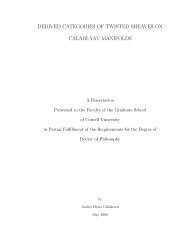Modifications of the Harmonic Series - Department of Mathematics
Modifications of the Harmonic Series - Department of Mathematics
Modifications of the Harmonic Series - Department of Mathematics
You also want an ePaper? Increase the reach of your titles
YUMPU automatically turns print PDFs into web optimized ePapers that Google loves.
We can also use <strong>the</strong>se <strong>the</strong>orems for modifications <strong>of</strong> <strong>the</strong> harmonic series in<br />
different bases. Although <strong>the</strong> series will still be partitioned based on <strong>the</strong> number <strong>of</strong><br />
digits in <strong>the</strong> denominator, <strong>the</strong> values <strong>of</strong> and<br />
i<br />
However, if b is <strong>the</strong> base, <strong>the</strong>n<br />
N i<br />
M will change as <strong>the</strong> base changes.<br />
i 1<br />
i = ( −1) ⋅ and we can choose ( ) 1<br />
1 i−<br />
M i b<br />
N b b −<br />
= .<br />
Then we still have that M i+ 1Ni+ 1 MiNi − ∑ converges, and { MiN i}<br />
is monotonically<br />
decreasing. Table 4 shows a few modifications <strong>of</strong> <strong>the</strong> harmonic series in different<br />
bases.<br />
Table 4<br />
Base Modification** i r i p<br />
1<br />
3 The digit 2 is forbidden 12 i−<br />
1<br />
4 The digit 2 is forbidden 23 i−<br />
1<br />
7 The digit 2 is forbidden 56 i−<br />
1<br />
12 The digit 2 is forbidden 10 11 i−<br />
⋅ ( ) 1<br />
1 2<br />
2 3<br />
i−<br />
⋅ ( ) 1<br />
2 3<br />
i p ∑<br />
converges<br />
' n a ∑<br />
converges<br />
⋅ Yes Yes<br />
3 4<br />
i−<br />
⋅ ( ) 1<br />
5 6<br />
⋅ Yes Yes<br />
6 7<br />
i−<br />
⋅ ( ) 1<br />
10 11<br />
⋅ Yes Yes<br />
11 ⋅ 12 Yes Yes<br />
3 No consecutive digits 0 0 Yes Yes<br />
4 No consecutive digits 3 ( ) 1<br />
1<br />
i−<br />
Yes Yes<br />
1<br />
7 No consecutive digits 64 i−<br />
⋅ ( ) 1<br />
4<br />
12 No consecutive digits 1<br />
11 9 i−<br />
⋅ ( ) 1<br />
9<br />
i−<br />
12<br />
3 Only consecutive digits 1<br />
23 i−<br />
⋅ 1 No<br />
4 Only consecutive digits 3 i ( ) 1<br />
3<br />
i−<br />
4<br />
1<br />
7 Only consecutive digits 63 i−<br />
1<br />
12 Only consecutive digits 11 3 i−<br />
4<br />
7<br />
i−<br />
⋅ ( ) 1<br />
3<br />
7<br />
i−<br />
⋅ ( ) 1<br />
3<br />
12<br />
i−<br />
i−<br />
Yes Yes<br />
Yes Yes<br />
Yes Yes<br />
Yes Yes<br />
Yes Yes<br />
** The modifications described as “No consecutive digits” are modified series where<br />
<strong>the</strong> denominators have no consecutive digits that are consecutive numbers. The<br />
modifications described as “Only consecutive digits” are modified series where <strong>the</strong><br />
denominators have every consecutive digit being a consecutive number. Here,<br />
numbers in base b are considered consecutive if <strong>the</strong>y are adjacent to each o<strong>the</strong>r in <strong>the</strong><br />
cyclic set { 0,1,..., b −1}<br />
. As before, every number is consecutive to itself.<br />
19
















